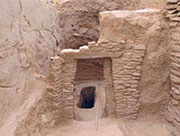

Bali, the one-month-old calf, is the fourth greater one-horned rhino to be born in the world in the past 12 months
When the baby was born at Whipsnade Zoo, Bedfordshire, on September 6, he weighed a massive 12 stone (76kg)
Whipsnade Zoo was one of the first zoos in the world to begin breeding the rhinos, in 1957, and has seen 14 calves
Native to India and Nepal, there are believed to be fewer than 3,000 of the greater one-horned rhinos left in the wild
A one-month-old endangered rhino calf has been photographed out and about with mum at Whipsnade Zoo.
The adorable series of snapshots shows the young calf Bali, meaning ‘strong’ in Nepali, in one of his first public appearances at the Bedfordshire zoo.
The greater one-horned rhino calf, which was born on September 6, was just the fourth to be born in the world in the past 12 months.
When the calf was born to 19-year-old mother Behan, after a 17-month gestation period, he weighed an incredible 12 stone (76kg).
Deputy team leader Veronica Watkins said, at the time of his birth: ‘The whole team are very excited to see the safe arrival of our newest rhino.
‘To be involved in bringing one of these endangered animals into the world makes all of our efforts feel worthwhile, and it makes celebrating World Rhino Day this year feel extra special.
‘The labour was relatively straightforward. Behan was restless the previous night so we suspected the birth was imminent, but once her waters broke we were able to monitor her carefully through CCTV cameras, without interfering in the process.
‘The following day Bali was up and about, looking around at everything inquisitively.
‘Behan, who has always been an excellent mother to her calves, was staying very close to him.’
Bali is the 14th greater one-horned rhino to be born at Whipsnade, after the zoo became of the first in the world to breed the species in 1957.
He is the fourth calf born to mother Behan, but all her other babies have been moved to other zoos to breed as part of the European Endangered Species Programme.
Native to India and Nepal, there are thought to be fewer than 3,000 greater one-horned rhinos left in the wild.
 |
Day|Week

 China enters Go Away, Mr. Tumor for 88th Oscars
China enters Go Away, Mr. Tumor for 88th Oscars Highlights of the National Day holiday
Highlights of the National Day holiday Chinese peacekeeping forces in South Sudan encounter armed conflicts
Chinese peacekeeping forces in South Sudan encounter armed conflicts "Luxury" art apples debut in Shanghai
"Luxury" art apples debut in Shanghai Photos and hand-painted pictures brighten the military training life
Photos and hand-painted pictures brighten the military training life Models steal the light at Nanjing auto expo
Models steal the light at Nanjing auto expo Magnificent Xian H-6 strategic bomber
Magnificent Xian H-6 strategic bomber Bikini models compete in oriental beauty pageant
Bikini models compete in oriental beauty pageant Archaeologists find 4,000-year-old sentry post in Shaanxi
Archaeologists find 4,000-year-old sentry post in Shaanxi Stunning photos of air show in China’s V-Day parade
Stunning photos of air show in China’s V-Day parade